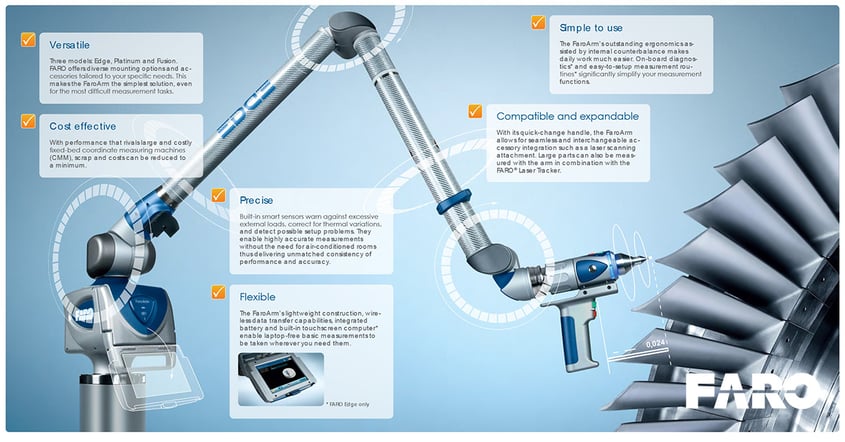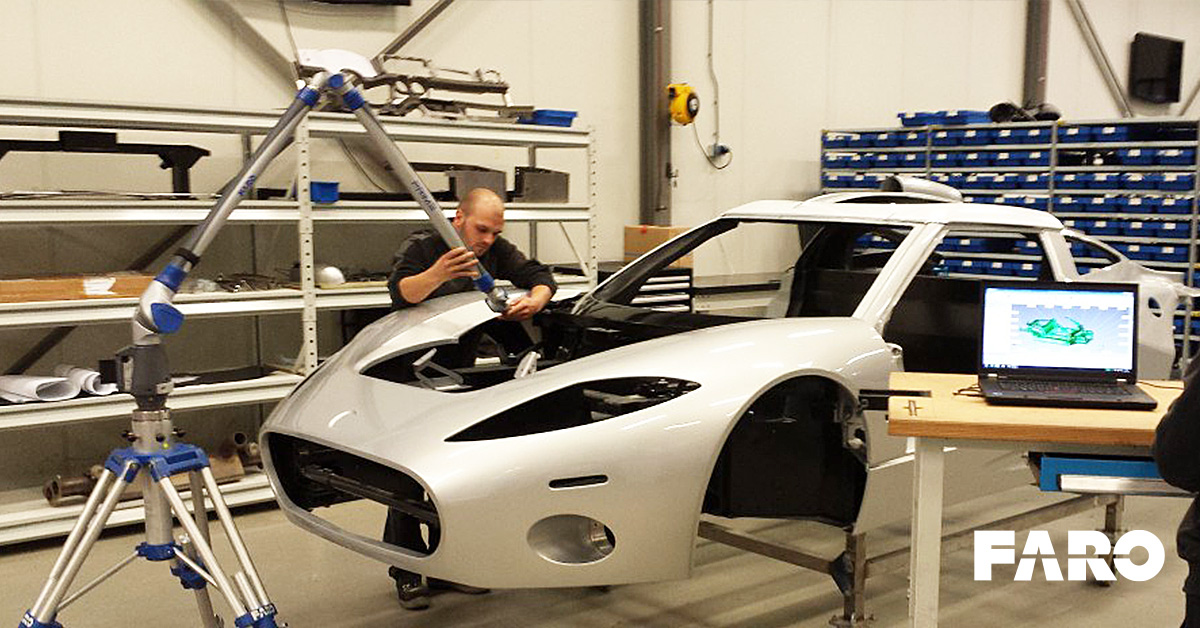3D measurement arms, commonly known as articulating arms, are portable coordinate measuring machines (CMMs) that determine and record the location of a probe in 3D space and report the results through software. The name derives from the actual look of the hardware, resembling a human arm with a shoulder, elbow, forearm and wrist. To ascertain the position of a probe, the arms contain proprietary glass discs in each joint, called encoders, that calculate the probe’s position as the arm moves freely throughout its workspace.
When fully extended, the radial reach of an arm typically ranges from 2 to 6 feet. In the CMM industry, arms are classified by the overall working volume, from 4 feet all the way to 12 feet. The shorter the arm, the more accurate it is because there is less mechanical error linked to the length of the sections. Arms may also be classified by the number of rotation axes. Arms typically come with 6 axes of rotation, but if an arm has a handle at the end of the unit to control a rotating wrist, it is considered a 7-axis arm.
One of the main benefits of using an arm is its portability. Compared to a traditional CMM, arms are considerably smaller and lighter and thus, can be taken to a part for inspection instead of the part travelling to the CMM, minimizing machine downtime and quality control bottlenecks. Furthermore, arms are designed to adapt to most temperature conditions so they can work in a wide range of environments and are not confined to a temperature-controlled inspection room. The accuracy of arm CMMs exceeds a majority of the hand tools often used to do an inspector’s job. In addition to being substantially less expensive than fixed CMMs, arm CMMs are also easier to use, with simple buttons on the handle that are used to collect data.
Applications
Typical applications for an articulated arm include:
- Dimensional Analysis: Collect information on parts to compare data to drawings and blueprints
- CAD-Based Inspection: Compare your part to a 3D CAD model in real time for instant feedback
- On-Machine Inspection: Utilize the portability of an arm and inspect a part before, during and after its production, all while mounted on a machine tool
- First Article Inspection: Review pre-production samples and compare against nominal data
- Alignment: Align tools and fixtures to the correct orientation
- Reverse Engineering: Capture unique details on a part with the arm or laser line scanner to create CAD models for fabrication or digital documentation
Articulating Arms vs Other Measurement Methods
For hundreds of years, hand measurement tools such as micrometres and Vernier callipers were utilized to capture dimensions on parts. However, due to their mechanical simplicity, hand tools could only provide basic measurements such as widths, lengths, and thicknesses. If complex dimensions such as form (flatness, circularity, etc.) or hole-to-hole dimensions were desired, manual measurements would be considered time-consuming. Although they provided the best accuracy and precision at the time, hand tools often required skilled operators as manual measurements were always susceptible to human error.
Coordinate measuring machines were then introduced in the 1960s for machinists and engineers to capture various geometries and measurements with higher accuracy than hand tools. Fixed CMMs typically consist of a measurement bed, a measurement probe (fixed to a bridge), a computer and measuring software to program the measurement probe. The probe can only move in three axes and only travel within the extent of the CMMs measurement bed. With the advancement of technology, articulating arm CMMs were invented to provide the same functionality as a fixed CMM, but also provide portability and flexibility as well. Though articulating arms may not have as fine an accuracy as fixed CMMs, they are lightweight (20 pounds or less), simple to operate, and far less expensive than a fixed CMM, all while providing the necessary accuracy for a wide variety of measurement applications.

Articulating Arms with Laser Line Scanners
Articulating arms may also be affixed with a laser line scanner. The laser scanner allows users to collect data on a part without direct contact, similar to painting a part with a spray gun. A laser scanner can quickly capture data (known as point clouds) at a high frequency, resulting in millions of points that can later be turned into a CAD model. Benefits of scanning with a laser include speed in collecting the data, ease of use (just point and shoot), and less risk of impacting a part during a measurement.
Laser scanners used with articulating arms typically consist of a camera and a laser. The laser emitted from a laser scanner generally will be represented as a laser stripe or a moving laser dot that resembles a laser line. The laser line is then projected onto a part, and the camera captures information based on the position of the laser on the part, creating three-dimensional points. The points are then communicated back to a computer. Points can be collected anywhere from 10,000 to 500,000 points per second.
Applications with a Laser Line Scanner
Typical applications for an arm with a laser scanner include:
- CAD-Based Inspection: Compare point cloud data to a CAD model in real time
- Reverse Engineering: Collect three-dimensional information about a part to produce a 3D model
- First Article Inspections: Capture details on an individual part to compare to a CAD model and archive for company records
- Artefact Documentation: Archive digital information for research or historical replication
Articulating arms combine the efficiency, reliability and accuracy of a traditional CMM with the portability and simplicity of hand tools. With the addition of a laser line scanner, parts that were once considered sophisticated or complex can now be easily inspected with an arm. Reduced scrap, faster inspections, fewer defects and an improvement in product quality are just some of the many benefits a company will experience when they implement an articulating arm for their inspection and manufacturing needs. These benefits ultimately result in a significant return on investment for a company.



